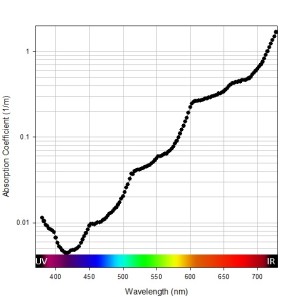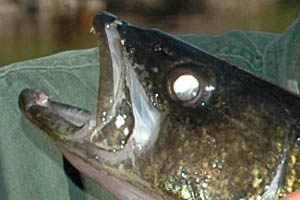The various senses that fish use to navigate their watery world are of utmost interest to us as anglers. For each species a particular set of senses will dominate their hunt for food and our knowledge of this can be used to fool them to take our bait. As with most animals the five senses of sight, hearing, smell, taste and touch are present. Fish also have a unique sense known as the lateral line which enables them to sense danger and find food even when they cannot see. The next few posts will look at some of the nuances of how various species use the different senses.
…fish can see through a window through the surface which has a diameter of about twice that of its depth.
1) Sight
The are a number of important factors about how fish see in their world with one major factor being the water itself. Due to the physics of how light travels in different media (water and air) a fish can see through a window through the surface which has a diameter of about twice that of its depth. So a fish at 6 feet of depth will be able to see through a circular window of about 12 feet in diameter above him. In addition to this, the bending of the light when entering the water means that the fish can see objects above the water far to the side of this window. Outside of this window the light from below is bounced off the water/air interface so the fish will see a mirror of the bottom structure. Good information to know when stalking fish in clear water.
Water clarity will also play a huge role. Some fish are able to see 100 feet or more in very clear water although a more realistic range for most lakes would be 10-20 feet. As water clarity deteriorates other senses become more important.

Figure 1. The absorption coefficient of water throughout the visible spectrum of light. A higher absorption coefficient (such as for red) will mean that color is absorbed quicker and will not be visible deeper in the water column. Blues will be seen at greatest depths.
Red is the first to disappear, then orange, yellow, green and blue – with blue being seen deeper than all other colors.
Fish will also have varying abilities to see at night. Some fish have what is known as a tapetum lucidum, which is a layer of tissue immediately behind the retina that reflects light back through the retina, increasing the light available to the photoreceptors (though blurring the initial image of the light on focus). Walleye, with their exceptional night vision, are equipped with this.

Figure 2. The appearance of eye shine, such as seen for walleye (or cats) indicates the presence of a tapetum lucidum, which allows for much improved night vision.
The contrast of a lure (as opposed to its actual color) will be more important at night than during the day. A black lure may be best against a dark sky while a white lure may be best on a moonlit night. (Light conditions play a significant role in lure color selection).
Another consideration is the positioning of the eyes on each particular species. Most fish have eyes oriented upwards and on the sides of the head leaving blind spots behind, below and a short distance in front of the fish. Further in front of the fish this will have 3D vision (good depth perception) while on the sides only 2D (poor depth perception) will be available. The eyeball shape (much rounder than mammals) suggests a large field of view (fish-eye view). Finally, the lack of eyelids in fishes is also important as on bright sunny days many fish will need to retreat to deeper water or find the shade of plants and structure.
Absorption spectrum recreated with data from:
R.M. Pope, E.S. Fry, Applied Optics 36 (1997) 8710-8723.



Pingback: Color Loss Underwater » The Scientific Fisherman
Pingback: Fish Senses: 2) Hearing and Lateral Line » The Scientific Fisherman